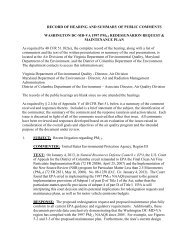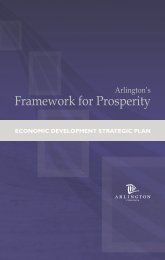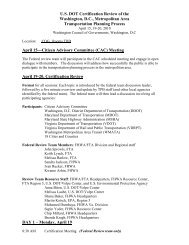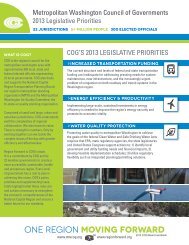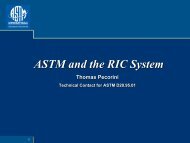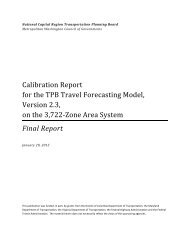PTI Local Government Energy Assurance Guidelines - Metropolitan ...
PTI Local Government Energy Assurance Guidelines - Metropolitan ...
PTI Local Government Energy Assurance Guidelines - Metropolitan ...
You also want an ePaper? Increase the reach of your titles
YUMPU automatically turns print PDFs into web optimized ePapers that Google loves.
As envisioned thus far, the smart grid will allow greater integration of renewables and distributed generation energy<br />
resources. Future operators of the smart grid will have the ability to switch energy sources and reroute energy supply<br />
to meet demand in advance of an energy emergency instead of only after the emergency. Working in concert with<br />
electricity utilities in the future, local governments may have the ability to better match energy demand with energy<br />
supplies before, during and after an emergency. Smaller-scale distributed energy resources will be easier to tap into<br />
and exploit for energy emergency needs, with the smarter controls that come with the new smart grid. Again, energy<br />
assurance is about diversifying energy supplies and spreading risk across multiple energy resources.<br />
Advanced Metering Infrastructure technologies are already available to help local governments reduce peak demand<br />
and manage electricity load. For example, meter modules can be added to existing meters to send real-time data<br />
to vehicle-based mobile collection systems, radio-equipped handheld computers, and advanced “fixed network”<br />
systems. These metering technologies can be deployed over geographic areas that can range in size from a small<br />
neighborhood or apartment complex to a large metropolitan area. Other advanced metering technologies make<br />
efficient use of existing telephone and cellular communication networks to communicate with the meter and send<br />
data to the utility company. While the costs of this technology will vary for local government applications, the<br />
average cost of a meter module that is attached to an existing meter is approximately $50 for a meter on a residential<br />
home, and $500 for commercial or industrial facilities. More than 85 percent of meters in the U.S. can be retrofitted<br />
with these meter modules and do not require the purchase and installation of a new meter. 7<br />
The safety and security of the local energy supply should benefit from the deployment of smart grid technologies.<br />
For example, terrorists and saboteurs have less ability to impact power supplies when a new, smarter electricity<br />
system automatically reroutes energy supply sources to where they are needed in an emergency. A smart grid can<br />
also be used to reduce peak electricity through load management, which in turn reduces the stress on the grid.<br />
Reducing peak power demand in this manner has the potential to reduce the cost of energy production, and therefore<br />
the price to the consumer. Advanced metering technology can facilitate the implementation of time-of-use rates,<br />
which can help level out the 24-hour load profile. This also can have a positive effect on energy bills, and can reduce<br />
the need for continued power generation capacity building.<br />
It makes good business sense to contact the local utility to learn about any planned or existing smart grid projects.<br />
This new information can be incorporated into EAP efforts, and it might also provide planners with the opportunity<br />
to learn more about local government applications of smart grid technologies.<br />
2.6.2 Renewable <strong>Energy</strong> Technologies<br />
Renewable energy comes from sources that renew themselves constantly over short periods of time—minutes, days,<br />
or months, instead of centuries. These sources of energy usually include water, wind, solar, biomass, and geothermal<br />
heat from the earth’s interior. While quickly replenished, these resources tend to be intermittent on either a daily or<br />
seasonal basis (e.g., the wind does not always blow and the sun does not always shine). This section highlights three<br />
real-life case studies to illustrate renewable energy options that support energy assurance activities.<br />
Fuel routing challenges have proved formidable for many local governments during recent hurricanes and other<br />
natural disasters—these governments had stockpiled ample supplies of diesel fuel, but found it difficult to get the<br />
fuel to the places where it was needed. For example, in Louisiana streets turned to rivers during Hurricane Katrina,<br />
and boats were needed to transport the fuel instead of trucks. On-site distributed renewable energy technologies,<br />
including solar photovoltaics, are now being considered by cities to provide power generation to key assets and<br />
services when transport of fuel for backup electricity generators might be hampered by weather or other conditions.<br />
7<br />
ITRON, The Critical Role of Advanced Metering Technology in Optimizing <strong>Energy</strong> Delivery and Efficiency: A Report to the U.S.<br />
Department of <strong>Energy</strong>, undated, circa 2010.<br />
16 | 2 – Issues to Consider When Developing a <strong>Local</strong> <strong>Energy</strong> <strong>Assurance</strong> Plan



